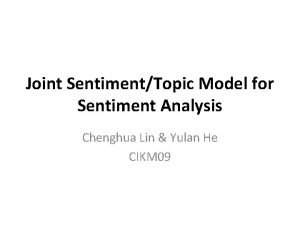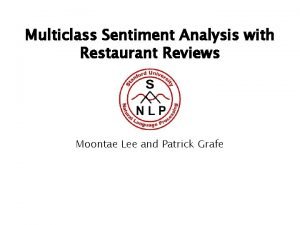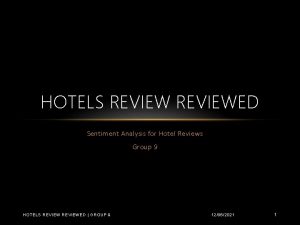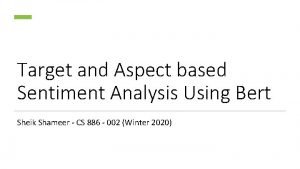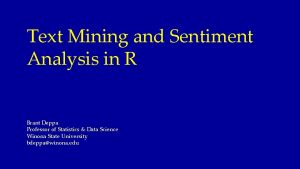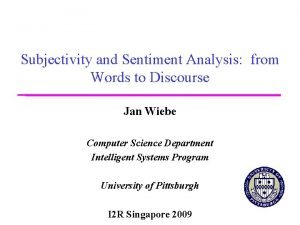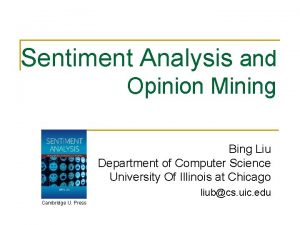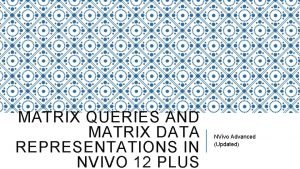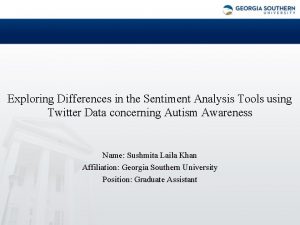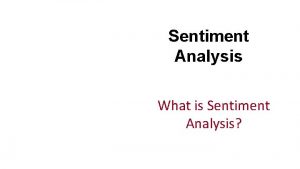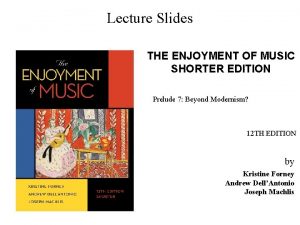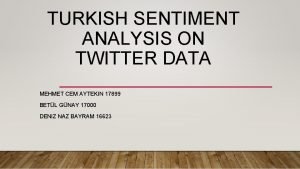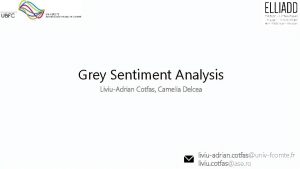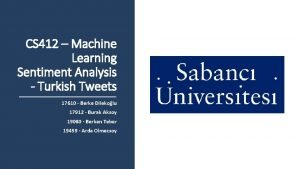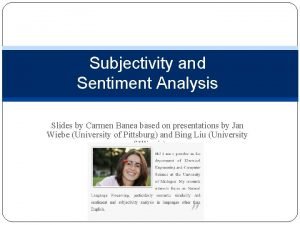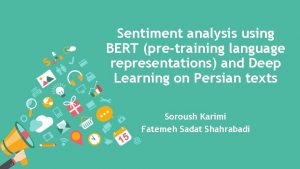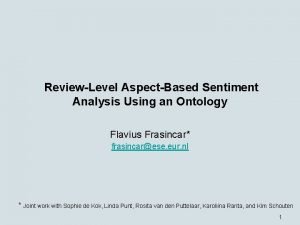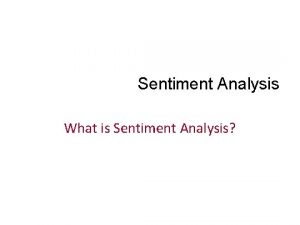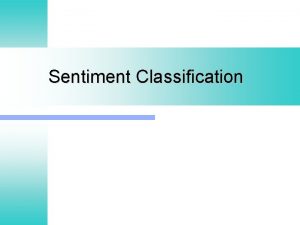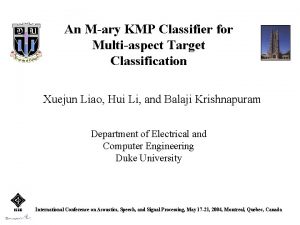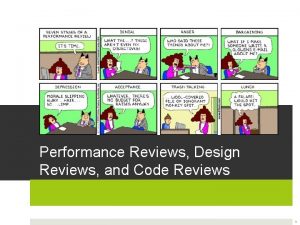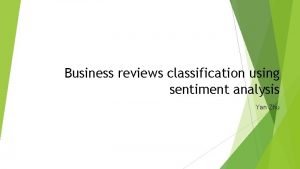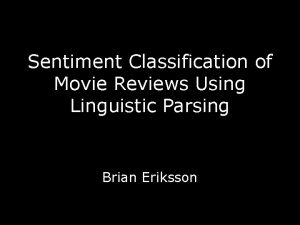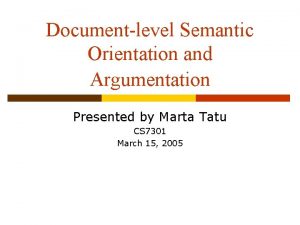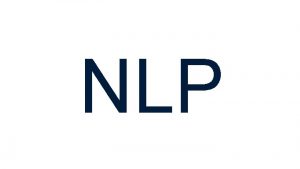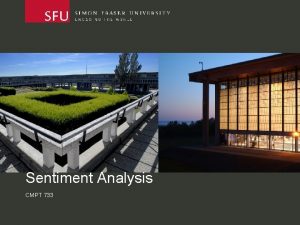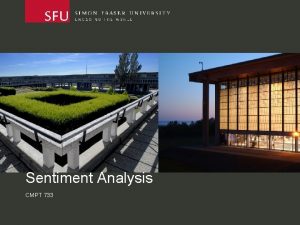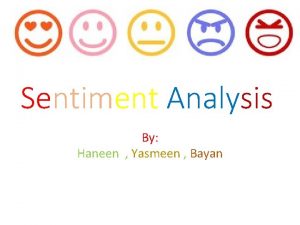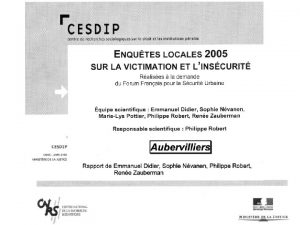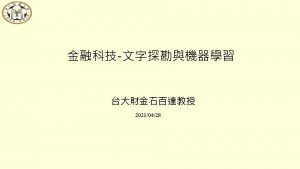DocumentLevel MultiAspect Sentiment Classification for Online Reviews of
























- Slides: 24

Document-Level Multi-Aspect Sentiment Classification for Online Reviews of Medical Experts ADVISOR: JIA-LING KOH SOURCE: CIKM 19 SPEAKER: LI-WEI Li. U DATA: 2020/05/11 1

OUTLINE l. Introduction l. Method l. Experiment l. Conclusion 2

INTRODUCTION Online doctor review system: Provide a platform for doctors and patients to operate and select Patient comments on the doctor https: //www. ratemds. com/ 3

INTRODUCTION Goal: üAutomatically score through patient comments on doctors üFor multiple aspects respectively Document-Level Multi-Aspect Sentiment Classification(DLMASC) 4

INTRODUCTION Document-Level Multi-Aspect Sentiment Classification(DLMASC) Output: Rating for each aspect Input: A review (Patient comments on the docto) 5

OUTLINE l. Introduction l. Method l. Experiment l. Conclusion 6

FRAMEWORK Multiple tasks, shared parameters predict rating features of doctors reviews aspect-keywords How to get? keywords for aspect k 7

METHOD Discover Aspect-Keywords • Latent Dirichlet Allocation(LDA) – Unsupervised Find the most relevant top-k keywords 8

METHOD Discover Aspect-Keywords • In our dataset… 9

METHOD for aspect k • Review Encoder Input: review X(x 1, x 2, …, x. T) Enbedding: (Ex 1, Ex 2, …, Ex. T) where Ext is the word vector of xt Bi-directional GRU: hidden states H=(h 1, h 2, …, h. M) 10

METHOD for aspect k • Multi-Aspect Self-Attention Determine attention weights αkt of each token in the review Representation of the review : sum of all hidden states 11

METHOD for aspect k • Aspect-Keywords Guided-Attention Given a list of aspect-keywords for aspect k: (gk 1, gk 2, . . . , gk. M) And enbedding as: (Egk 1, Egk 2, …, Egk. M) Each word vector is transformed into a hidden state with: Zt rt 12

METHOD for aspect k • Aspect-Keywords Guided-Attention Concatenating all hidden states into a single vector vk=[vk 1 , vk 2 , . . . , vk. M] Calculate alignment scores between encoded vectors of aspect-keywords and tokens in the review as: The guided-attention weights and vector representation of the review: 13

METHOD for aspect k • Aspect-Specific Feature Encoder We embed one hot representations of features of doctors into a continuous vector space for each aspect k as Feature of doctors : specialties, insurance plans, locations, genders and facilities 14

METHOD for aspect k • Multi-Aspect Rating Prediction Classifier to predict rating: A single layer feed-forward network with a softmax activation function Integer score from 1 to 5 15

METHOD • Loss function Score from 1 to 5 Parameter set including all weight matrices and bias vectors 16

OUTLINE l. Introduction l. Method l. Experiment l. Conclusion 17

EXPERIMENT Data. Sets ratemds-us and ratemds-ca 90% of reviews are from these two countries reviews doctors ratemds-us 1, 414, 235 385, 407 ratemds-ca 1, 252, 941 99, 719 Randomly split each dataset into training/development/testing sets at the ratio of 0. 8/0. 1. 18

EXPERIMENT Comparison with Previous Models (‘Macro’ avg F-score and MSE) 19

EXPERIMENT Comparison with Previous Models (‘Macro’ avg F-score and MSE) 20

EXPERIMENT Attention Visualization (ground-truth, predicted rating) Self-ATT weight Guided-ATT weight 21

EXPERIMENT Attention Visualization See Figure 7 Failure of attention may be caused by: u. Short Review or does not cover all aspects. u. May be mixed with unrelated sentences. u. Many keywords and phrases are ambiguous in different context. 22

OUTLINE l. Introduction l. Method l. Experiment l. Conclusion 23

CONCLUSION üWe attempted to explore content of reviews by extracting aspectkeywords with the topic modeling. üThe proposed model takes both features of doctors and aspectkeywords into consideration. üWe proposed a multi-task learning framework for the document-level multi-aspect sentiment classification. 24
 Joint sentiment topic model for sentiment analysis
Joint sentiment topic model for sentiment analysis Multiclass sentiment analysis
Multiclass sentiment analysis Sentiment analysis for hotel reviews
Sentiment analysis for hotel reviews Bert aspect based sentiment analysis
Bert aspect based sentiment analysis My consult
My consult Streamlined online booking
Streamlined online booking Twitter sentiment analysis using spark streaming scala
Twitter sentiment analysis using spark streaming scala W62vr
W62vr Subjectivity in sentiment analysis
Subjectivity in sentiment analysis Bing images
Bing images Sentiment analysis nvivo
Sentiment analysis nvivo Sentiment analysis tools comparison
Sentiment analysis tools comparison Twitter sentiment
Twitter sentiment Chapter 64. less is more: reich and minimalist music
Chapter 64. less is more: reich and minimalist music Turkish sentiment analysis
Turkish sentiment analysis Github liviu cotfas
Github liviu cotfas Turkish sentiment analysis
Turkish sentiment analysis Azure twitter sentiment analysis
Azure twitter sentiment analysis Slide to doc.com
Slide to doc.com Unsupervised sentiment analysis using bert
Unsupervised sentiment analysis using bert Sentiment analysis conclusion
Sentiment analysis conclusion Public sentiment is everything
Public sentiment is everything Abolitionist sentiment grows
Abolitionist sentiment grows Fspos vägledning för kontinuitetshantering
Fspos vägledning för kontinuitetshantering Typiska drag för en novell
Typiska drag för en novell
